#megarhyssa macrurus
Explore tagged Tumblr posts
Text
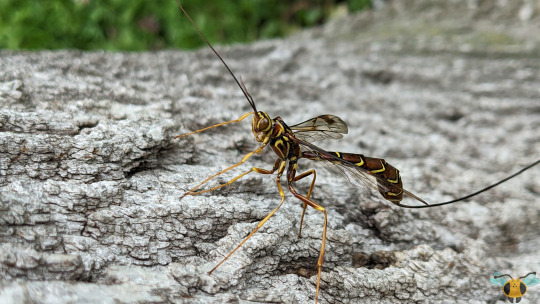


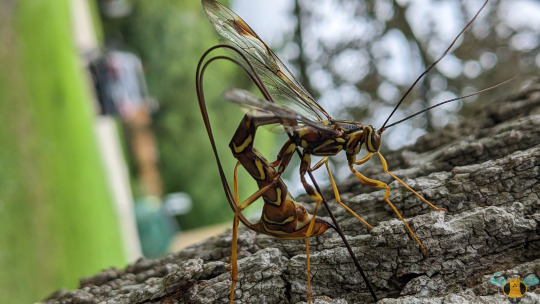
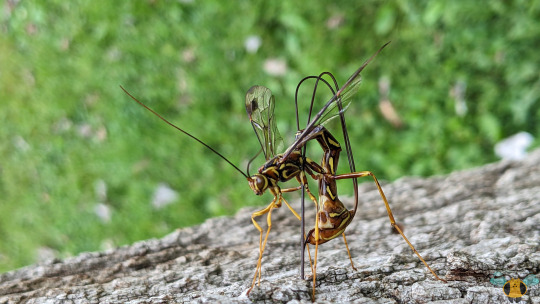


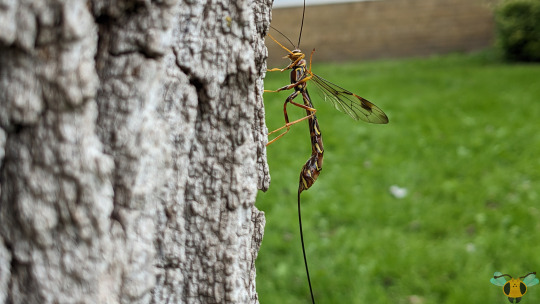

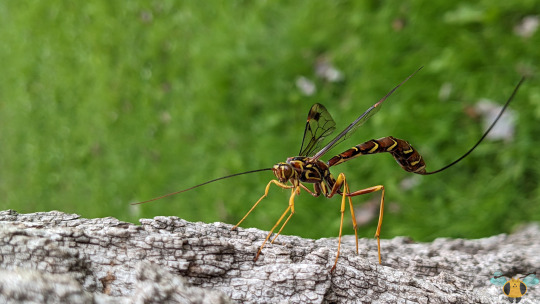
Long-Tailed Giant Ichneumonid Wasp - Megarhyssa macrurus
To anyone wondering why this giant wasn't included in the "Insect Highlights of 2023", it's simply because there were enough pictures taken to allow a second showcase! She's a very impressive creature, and I'm fortunate to have found her last year. I hope to find a few more specimens in the future, especially if they revisit the tree this one was exploring or similar trees in the surrounding area. As a reminder, Giant Ichneumonids like this specimen are drawn to old, decaying trees in search of Pigeon Horntail larvae for their own eggs. Using their elongated ovipositor they pierce through the wood like a syringe, paralyze a developing larva and place an egg on it. This whole process is done without even so much as seeing the larvae hidden in the tree trunk, but they are searched for via scent cues on the bark, listening for sounds via her legs and feeling for them with her sting as it is pressed downward! Though it looks unwieldy, it is surprisingly easy for an Ichneumon Wasp of this size to orient itself to "drill for larvae". When she's decided on a suitable location, she extends her abdomen and legs as far as they will go, orienting her ovipositor to be as vertical as possible! Since the ovipositor is long, it will take a series a fine adjustments to pull it in so that it lines up parallel to the abdomen.
After it is pressed into the tree trunk the ovipositor is fully unsheathed and the Long-Tailed Giant's search proceeds. The individual in these pictures had just begun to drill for larvae (and had re-sheathed upon my return 1 hour later) Although it may seem precarious, it's important to keep in mind that the ovipositor (which can be more than twice the length of the insect’s body) is not a stiff filament. It appears stiff while inside its sheath and carried behind the insect under normal circumstances. In fact, it is somewhat flexible and can be maneuvered around tree-bound obstacles while searching for larvae. The flexibility also offers an easier exit when withdrawing from the hole in the tree, but not a hasty one: should the ovipositor became damaged, the Wasp will not be able to lay eggs, so withdrawal is monitored carefully. If you'd really like to see an unwieldly "stinger", try and observe an Ichneumon flailing the ovipositor around and place it smoothly back inside her sheath! Do not fear when observing this imposing beauty; though the ovipositor is long and prominent, her "stinger" cannot harm a human. As you've read above, her stinging process requires a lot of telegraphing to be effective, and Ichneumonid adults are not predators nor are they interested in humans. Though Wasps, there is a world of difference between Ichneumonids and some of the more common social Wasps of Ontario.
Pictures were taken on August 24, 2023 with a Google Pixel 4.
#jonny’s insect catalogue#ontario insect#wasp#ichneumon wasp#long tailed giant ichneumonid wasp#megarhyssa macrurus#giant ichneumon#hymenoptera#insect#toronto#august2023#2023#nature#entomology#invertebrates#arthropods#animals#photography
16 notes
·
View notes
Text
begging the person i contacted to give me this dragon... i want to make her into alomya debellator ♥


#warning if you look that up it IS a wasp. but if you know me you know i loooove ichneumon wasps#i want to have multiple pairs for them!#i want to go for a megarhyssa macrurus look next#★🪲#that is the m pose btw but i like it more than f dusthide pose. In my mind I am building like a genderless lesbian wasp army.#also: the absolute panic from the back of our brain due to cofront that is 'PLEASE STOP LOOKING AT WASPS' is so funny#No. Look at my parasitic beauties boy!!!!!!!!!#ICHNEUMONIDAE DEFENDER FIRST HUMAN NEVER !!!
1 note
·
View note
Text










Lots of Megarhyssa spp. ovipositing on dying beech! M. atrata and M. macrurus or greenei. I always enjoy seeing these Ichneumonids! Ottawa, Ontario, Canada.
#hymenoptera#insect#entomology#wasp#wasps#apocrita#parasitica#Ichneumonoidea#Ichneumonidae#Rhyssinae#Megarhyssa#Megarhyssaatrata#Megarhyssamacrurus#Megarhyssagreenei#GiantIchneumonWasp
2K notes
·
View notes
Text

InsertAnInvert 2024
Parasites week 4: parasitoids
long-tailed giant ichneumonid (megarhyssa macrurus)
#art#comics#artists on tumblr#screentone#halftone#invertebrates#inverts#sciart#noAI#human artist#queer artist#nonbinary artist#cute#animals#SciArt#insertaninvert2024#insertaninvert#nature#funny little guys#parasite#ovipositor#ichneumonid
147 notes
·
View notes
Note
Hello there! I say this with so much love in my heart, but what the hell is this. (Located in eastern Colorado, USA)

Wasp ID - CO, USA:
Hello, yes, this is a female Long-tailed Giant Ichneumonid Wasp (Megarhyssa macrurus), family Ichneumonidae.
That long structure sticking out the back of the abdomen is the ovipositor, from which they lay eggs...
Megarhyssa macrurus - Wikipedia
Species Megarhyssa macrurus - Long-tailed Giant Ichneumonid Wasp - BugGuide.Net
127 notes
·
View notes
Text
Uncharismatic Fact of the Day
As every expecting mother knows, finding the perfect place to lay your eggs is of the utmost importance. That's why the long-tailed giant ichneumonid wasp has such a long ovipositor! This special organ is more than twice the wasp's body length, and is used to tunnel deep into decaying wood in order to deposit their egg on the body of their host species the pigeon horntail (Tremex columba).
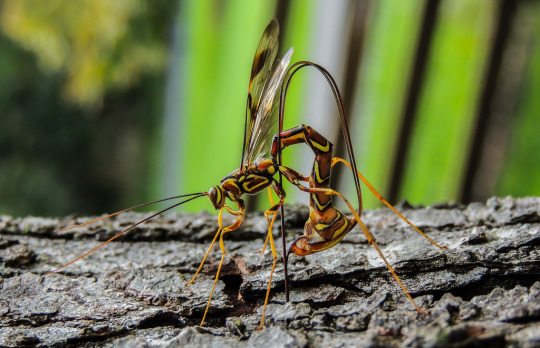
(Image: A female long-tailed giant ichneumonid wasp (Megarhyssa macrurus) depositing her egg by Richard Orr)
If you like what I do, consider leaving a tip or buying me a ko-fi!
#long-tailed giant ichneumonid wasp#hymenoptera#Ichneumonidae#giant ichneumonid wasps#ichneumonid wasps#wasps#hymenoptrids#insects#arthropods#uncharismatic facts
166 notes
·
View notes
Note
Trick or Treat!
You get one (1) Megarhyssa macrurus

31 notes
·
View notes
Note
…ᘛ⁐̤ᕐᐷ <(trick or treat!!)

Megarhyssa macrurus!
26 notes
·
View notes
Text
I looked up what bug this is, she is named Megarhyssa macrurus. she uses her tail to lay her eggs in the nests of other insects, who are burrowed in wood. when her eggs hatch they kill and eat the young of the other insect lol. what an odd bug!
5 notes
·
View notes
Text
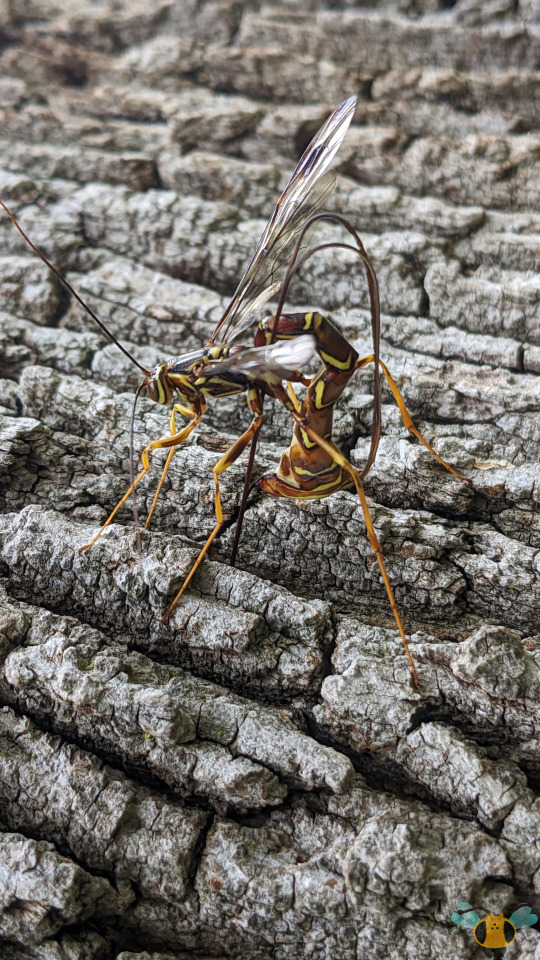

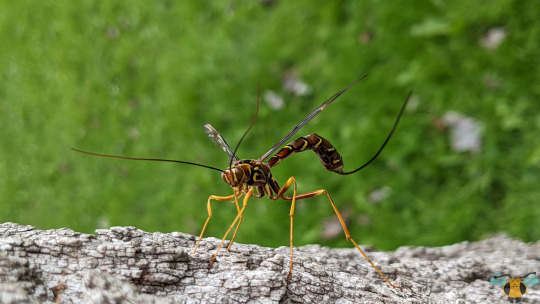


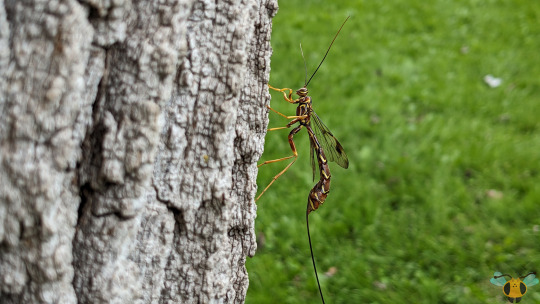
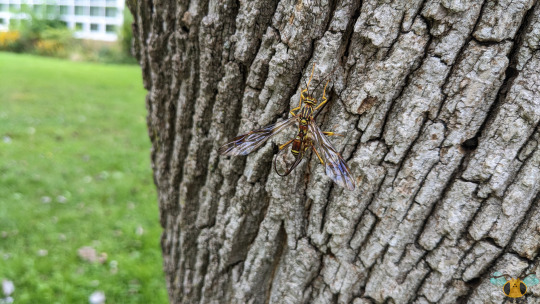



Long-Tailed Giant Ichneumonid Wasp - Megarhyssa macrurus
After finding this specie just yesterday, uploading Tuesday's post now feels like the appetizer before today's main course: one of the largest Ichneumon Wasps you'll find in North America! This insect is so iconic and recognizable that it actually has a common name! That name perfectly encapsulates this insect's features: its giant size (easily dwarfing that of other Ichneumonids) and its long tail, represented by a long, flexible abdomen tipped with an elongated ovipositor. Have a glance at Picture 5 and behold the length; the ovipositor is easily twice the length of the insect's body. Despite the formidable appearance of a potential angry Wasp wielding what appears to be sword for a stinger, she is 100% harmless to humans. She has no bite and her ovipositor is not designed for defense. Even if the latter was, it's fair too unwieldly to use in an instant. She would have to telegraph her sting by contorting into the posture in Pictures 1, 2, 4 and 7. The worst she can do is charge at you in an attempt to frighten you away should you step too close to her tree (as I found out during my observation).
When observing Giant Ichneumonids such as this one, pay close attention to their wings, abdomens and their faces. All those features are necessary for an accurate identification. For one example, male Wasps within Megarhyssa tend to be smaller, have less complex abdomens and lack an ovipositor, but are relatively large compared to other Ichneumonids. Secondly, of the 4 Giant Ichneumon species that call North America home, the female of this specie - M. macrurus - has the potential to be mistaken for Greene's Giant Ichneumonid Wasp (M. greenei), especially since the latter's subspecies have tremendous variability depending on their latitude. To distinguish between the two, the Long-Tailed Giant has more regions in its wings with pigmentation (as opposed to simply one large area), its head has distinct vertical stripes (Picture 9 provides a good look at what to expect), and the ovipositor is a very long one (M. greenei's ovipositor is supposedly 1.5 times the body length). For the latter, you'll need to eyeball it unless you intend to capture and measure the specimen yourself. Of course, I prefer to observe and photograph. Speaking of which, what is today's specimen doing on this tree? What is she looking for?
As I documented her, this Wasp monitored this tree for nearly 2 hours in search of the perfect spots to drill into the tree's trunk. Her searching activity on this tree implies that portions of the wood are afflicted with disease or have begun to decay. Those holes in the bark may indicate some trouble, but those holes were not made by her actions, nor the insects she's looking for. She's searching for the developing larvae of the Pigeon Horntail, (ironically) another harmless giant Hymenopteran that drills into old, decaying wood with its own ovipositor. Just like other Ichneumon Wasps, the giant's offspring are parasitic, feeding off of creatures that have been paralyzed by the mother's sting. When coiled up in the upright position, the Wasp unsheathes her great ovipositor and positions it and herself to drill downward through the wood to find larvae that she can place her eggs on. I believe her to be successful a few times here as I noticed the underside of her abdominal tip was pulsing rhythmically while the ovipositor remained steady. What's astounding is the process by which larvae are located. You see, the Pigeon Horntail merely needs to place eggs inside the tree and then go to the next tree. The Giant Ichneumon needs to seek out a Horntail larvae and place its eggs on it without even seeing it! The mother Wasp goes purely based on scent cues from her antennae and then feeling her way through the wood using her ovipositor.
Pictures were taken on August 24, 2023 with a Google Pixel 4.
#jonny’s insect catalogue#ontario insect#wasp#ichneumon wasp#long tailed giant ichneumonid wasp#megarhyssa macrurus#giant ichneumon#hymenoptera#insect#toronto#august2023#2023#nature#entomology#invertebrates#arthropods#animals#photography
6 notes
·
View notes
Text
[Image Description:
A collage of mostly plain hymenopterans. A very colorful bee says to a very flamboyant parasitoid wasp "Watch out… the stand user could be anyone"
There is only one other wasp that is as wild and colorful in their style as the two who are talking. The obvious "stand user" is Megarhyssa macrurus who is basically a JoJo character. ]

Idea from @hawkpartys
#bugblr#bugs#wasps#waspposting#wasplbr#hymenoptera#jojo#jojo's bizarre adventure#wasp fashion#parasitoid wasp
62 notes
·
View notes
Text
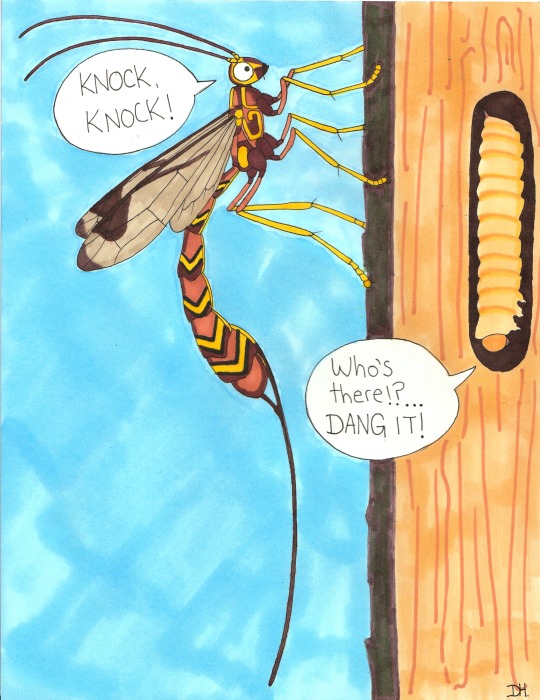
That horntail larva is doomed. Don't fall into the giant ichneumon "knock-knock" trap! While it is obvious that no dialogue happens in real life, Megarhyssa macrurus are able to detect their hosts (Tremex columba), through bark and parasitize them.
#hymenoptera#insect#entomology#wasp#wasps#apocrita#cartoon#comic#Megarhyssamacrurus#Tremexcolumba#giantichneumon#horntail#woodwasp#Ichneumonoidea#Rhyssinae#parasitica
428 notes
·
View notes
Photo
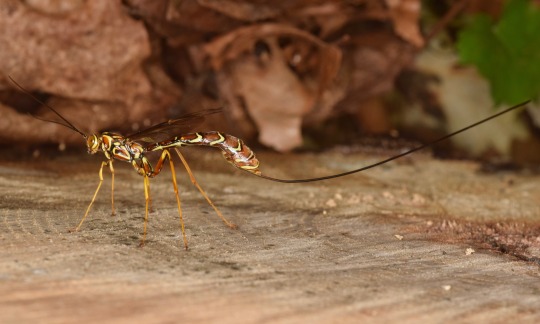
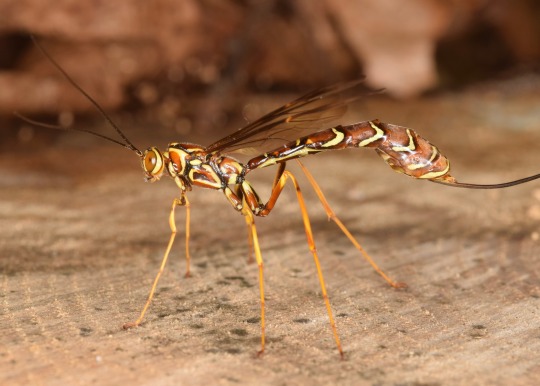
Megarhyssa macrurus ♀
175 notes
·
View notes
Photo


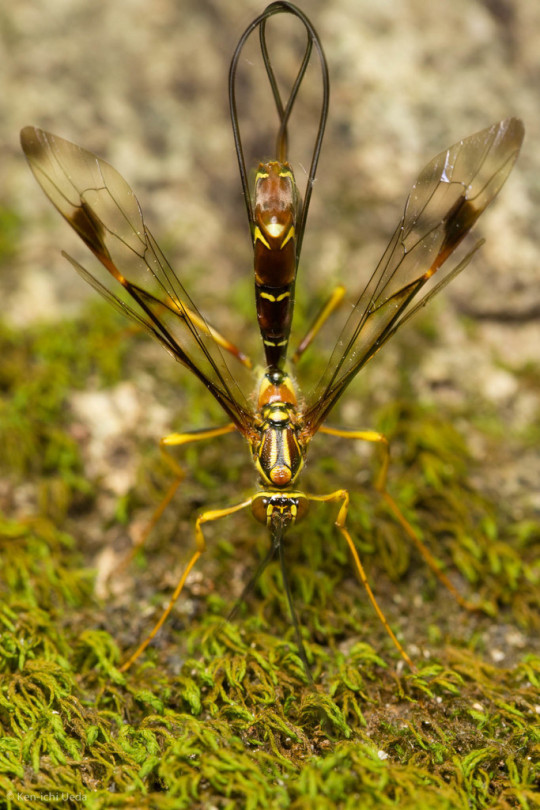
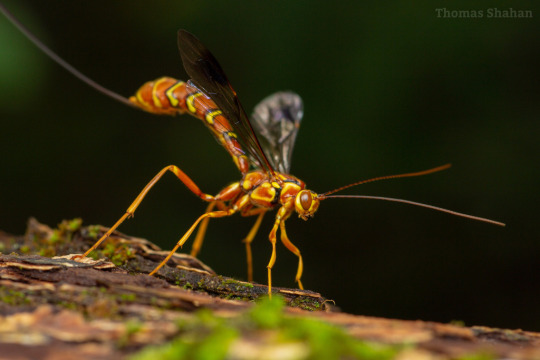
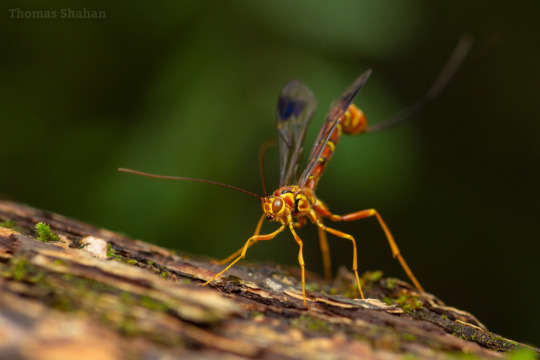
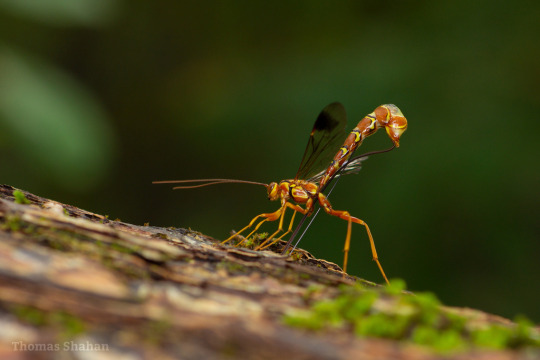
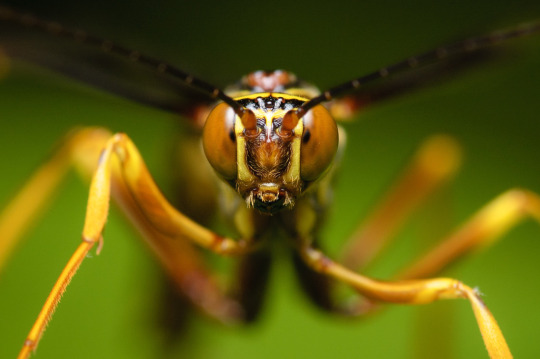
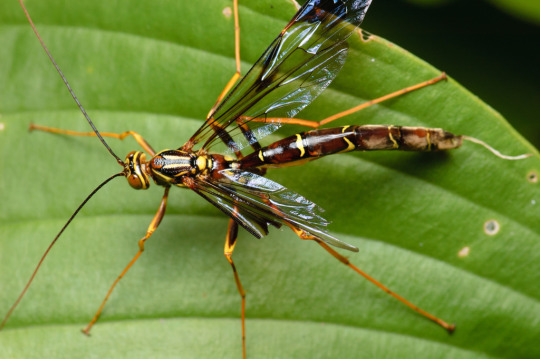


Long-tailed giant ichneumonid wasp, Megarhyssa macrurus, Ichneumonidae
Found in the eastern United States and up into southern Canada.
This species is a parasitoid of the larvae of the pigeon horntail, which bore tunnels in decaying wood. Female wasps detect larvae in the wood and use their long ovipositor to drill to them, paralyzing and laying an egg on the horntail larva. The wasp larva will then consume the body of the horntail larva before pupating and emerging as an adult wasp.
Photos 1-3 by kueda, 4-6 by tshahan, 7-8 by claggy, 9 by nashuagoats, and 10 (for scale) by shloftus
#animals#curators on tumblr#insects#bugs#wasp#ichneumonid wasp#Megarhyssa#giant ichneumonid wasp#long tailed giant ichneumonid wasp#one nice bug#parasitoid#bug death#mentioned
651 notes
·
View notes
Text
Same thing?



The World’s Longest Flight - In 1958 Two Men in a Cessna Flew For More Than Two Months Without Landing
24 notes
·
View notes
Photo
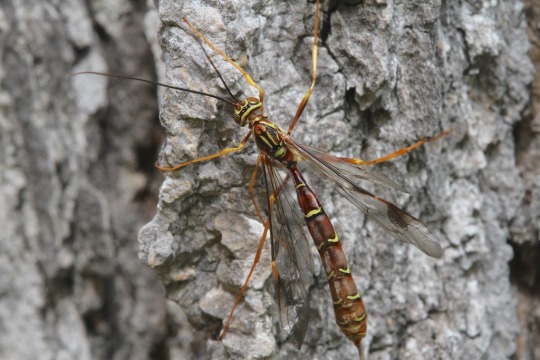
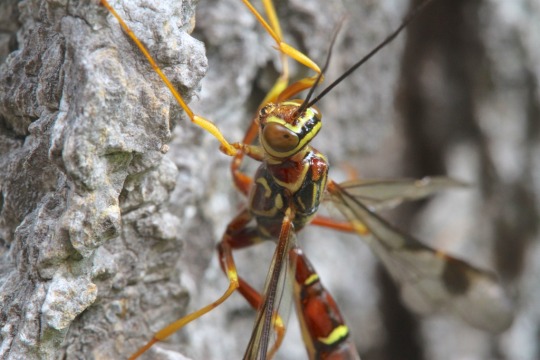
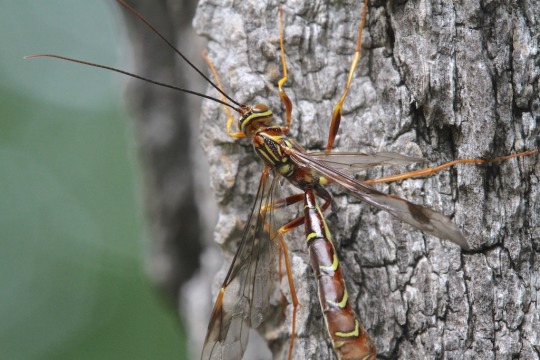

Megarhyssa macrurus, also known as the long-tailed giant ichneumon wasp
“I pollinate, I build nests fit for a queen, I consume swarms of parasitic pests. Call me hornet, wasp, yellow jacket, vespa, we coexist. When one tugs at a single thing in nature, one finds it attached to the rest of the universe.”
-Janet Austin
50 notes
·
View notes